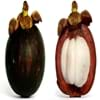Health Benefits
Good for diabetics, Improves well-being, Miraculin/miracle fruit makes sour things taste sweet
Cancer prevention, Cures gastro-intestinal troubles, Heart care, Increase in haemoglobin, Prevents diabetes
General Benefits
Has taste modifying effect
Anti-inflammatory properties, Boosts immune system, Digestive aid, Eye care, Flu treatment, Helps in weight loss, Maintains healthy cholesterol level, Treatment of common cold
Skin Benefits
NA
Anti-aging benefits, Brightens and lightens complexion, Reduces wrinkles, Skin revitalization, Treatment of dark spots
Hair Benefits
NA
Prevents hair loss, Promotes longer and healthier hair, Protects hair, Remedy for split ends, Treatment of dandruff
Allergy Symptoms
Itching, Skin rash
Abdominal pains, Anaphylaxis, Vomiting
Side Effects
Changes taste of food eaten after this fruit, Coagulation
Allergic reaction
Best Time to Eat
As a snack in the late afternoon, Eat the fresh ones, avoid mixing with any other foods, don't eat after meal., Morning time (before lunch)
As a snack in the late afternoon, Eat the fresh ones, avoid mixing with any other foods, don't eat after meal., Morning time (before lunch)
Protein to Carb Ratio
Not Available
Vitamin A (Retinol)
Not Available
Vitamin B1 (Thiamin)
Not Available
Vitamin B2 (Riboflavin)
Not Available
Vitamin B3 (Niacin)
Not Available
Vitamin B5 (Pantothenic Acid)
Not Available
Vitamin B6 (Pyridoxin)
Not Available
Vitamin B9 (Folic acid)
Not Available
Vitamin C (Ascorbic Acid)
Vitamin K (Phyllochinone)
Not Available
Lutein+Zeaxanthin
Not Available
Phytosterol
Not Available
Water Content
Not Available
Calories in Fresh Fruit with Peel
Not Available
Calories in Fresh Fruit without Peel
Not Available
Not Available
Calories in Frozen Form
Not Available
Calories in Dried Form
Not Available
Calories in Canned Form
Not Available
Calories in Juice
Not Available
Calories in Jam
Not Available
Calories in Pie
Not Available
Varieties
Gymnema Sylvestre and Thaumatococcus Daniellii
Victoria, President, Czar, Ariel, Avalon and Oullins Gage
Color
Dark red
Pink, Purple, Red
Inside Color
Greyish-white
Yellow
Taste
NA, Sweet
Juicy, Sweet, Tart
Origin
West Africa
Caucasus
Soil Type
Well-drained
Clay, Loam, Sandy loam
Climatic Conditions
Rainfall
Cold
Facts about
- The name 'Miracle' because of the magical experience you get after eating it.
- When you have lemon after eating this fruit, it tastes sweet as if it is added with sugar.
- It is also used as natural sweetener.
- In china, plums are used for production of wine.
- A chemical called amygdalin found in plum seeds, turns into toxic compound in human body.
- Plum tree produces fruit 3-5 yrs after planting.
Other Countries
NA
Bosnia, Chile, India, Iran, Italy, Romania, Serbia, Turkey, United States of America
Top Importer
Not Available
United Kingdom
Top Exporter
United States of America
Chile
Botanical Name
Synsepalum Dulcificum
Prunus domestica
Synonym
Miracle Berry, Miraculous Berry and Sweet Berry
Not Available
Subkingdom
Tracheobionta
Tracheobionta
Division
NA
Magnoliophyta
Subclass
Asteridae
Rosidae
Family
Sapotaceae
Rosaceae
Species
S. dulcificum
P. domestica
Generic Group
Not Available
Rose
Difference Between Miracle fruit and Plum
We might think that Miracle fruit and Plum are similar with respect to nutritional value and health benefits. But the nutrient content of both fruits is different. Miracle fruit and Plum Facts such as their taste, shape, color, and size are also distinct. The difference between Miracle fruit and Plum is explained here.
The amount of calories in 100 gm of fresh Miracle fruit and Plum with peel is Not Available and 46.00 kcal and the amount of calories without peel is Not Available and Not Available respectively. Thus, Miracle fruit and Plum belong to Low Calorie Fruits and Low Calorie Fruits category.These fruits might or might not differ with respect to their scientific classification. The order of Miracle fruit and Plum is Ericales and Rosales respectively. Miracle fruit belongs to Sapotaceae family and Plum belongs to Rosaceae family. Miracle fruit belongs to Synsepalum genus of S. dulcificum species and Plum belongs to Prunus genus of P. domestica species. Beings plants, both fruits belong to Plantae Kingdom.









